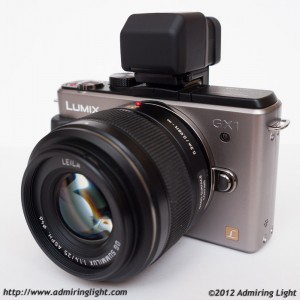Video
The GX1 is capable of shooting video at 1920x1080i full HD at 30 frames per second, or 720p at 60 frames per second. It shoots in either AVCHD or MPEG4. The controls for video are rather spartan, as you simply have control over exposure compensation and the starting and stopping of recording using the dedicated movie button. Focus can be re-locked at any time during filming by half pressing the shutter button, and full resolution stills can be captured during recording as well. The camera can also do focus tracking and continuous autofocus during movie recording. Movies are of very high quality, and can be used for some really excellent film making, though I would suggest if video is your primary goal, something along the lines of the Panasonic GH2 or GH1 would be much better suited to you, as they allow for full aperture, and shutter speed control, frame rate, etc. I am not much of a video shooter, so any decent mode here is a bonus for me. My GH2 sees 99% of my video use, as it well should.
External Viewfinder – LVF2

As mentioned earlier, the GX1 does not come with a built-in electronic viewfinder. Panasonic does offer the excellent LVF2, however. The LVF2 is a 1.44 million dot EVF with a 120Hz refresh rate and 1.4x magnification, virtually identical to the EVF in the G3. Because of the high magnification, the apparent viewfinder image is equivalent in size to most full frame professional DSLRs. It is crisp, clear and bright, and is a wonderful add-on, especially if you use manual focus. I generally prefer using a viewfinder, so I ordered the LVF2 with my GX1. The viewfinder is solidly made and attaches securely to the camera’s hotshoe and accessory port. The diopter adjustment is located underneath the viewfinder, and is accessible only when tilting up. This is a great location, as it’s easy to access, yet very difficult to accidentally knock out of position. The EVF tilts 90 degrees to allow top down shooting, which is great for low to the ground or macro shooting. It comes with a small velvet bag to pack the viewfinder in when not in use, and has a nice locking mechanism to prevent accidentally being knocked off the camera. Overall, it is a very well made piece of kit.
There are two issues with using the external viewfinder. First, it takes up the hotshoe, which means that you can’t use an external flashgun and the viewfinder at the same time. I understand the tradeoff, though, and it’s ultimately not too big of a deal. The second issue is that the EVF does not have an eye sensor, so you must manually switch between the EVF and LCD. Coming from the GH2, this is taking a long time to get used to. I generally make settings changes on the LCD, then raise my eye to the viewfinder (a holdover from my DSLR days). This isn’t really possible, without pressing the button on the EVF back and forth. Luckily, Panasonic did include an option (on by default) to do playback on the LCD automatically. If you are using the EVF and press the playback button, it will display on the LCD. This is a nice touch. I would love to have the option to display camera settings on the LCD when the EVF is active, much like the settings display available on the GH2 and other G series bodies.
Conclusion
The DMC-GX1 is a great little camera. It is responsive, compact, with excellent ergonomics, fast and accurate autofocus and very well placed and accessible controls. Panasonic also managed to squeeze in a bit better high ISO capability over their previous cameras, which makes this little camera capable of some very high-end output. On the down side, the EVF is still an accessory that must be purchased separately, and the camera lacks any serious video control. Image review is not possible until all images have been written to the card, an odd limitation that started with the GH2 and is not present on the G1 or GH1. That said, for still imaging, this is easily Panasonic’s best compact style CSC to date, and rivals the flagship of the Lumix line, the GH2, in everything but video. Outstanding.
Sample Images












Leave a Reply